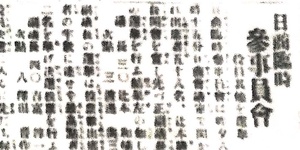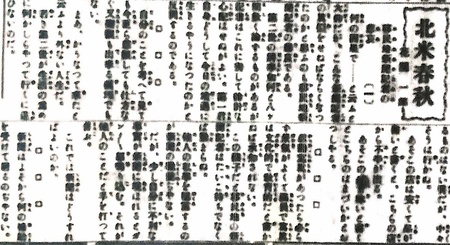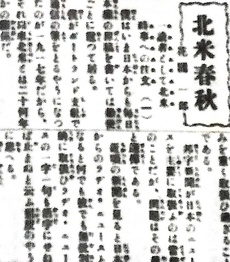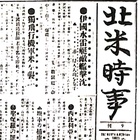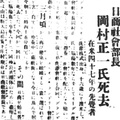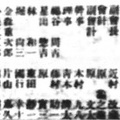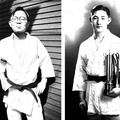The last part shared articles by a female employee of the North American Times, the 5000th anniversary issue and the increase of the subscription fee. This part features articles of Sumiyoshi Arima as Chairman of the Japanese Association and a newspaper reporter.
SUMIYOSHI ARIMA—CHAIRMAN OF THE JAPANESE ASSOCIATION
After Sumikiyo Arima retired, his eldest son, Sumiyoshi Arima, took over the position of president and publisher of The North American Times. He also became chairman of the Nihonjinkai (Japanese Association) in 1932; staying active in the Seattle Japanese community.
On March 3, 1938, Sumiyoshi Arima was re-elected as chairman of the Japanese Association. However, on March 4, the day after being elected, he resigned from the position and returned to Japan. Several articles explain the situation at that time.
“Arima Returns Home” (From the Mar. 4, 1938 issue)
“Sumiyoshi Arima has been preparing to return to Japan. Today, he left for Japan with his family, sailing on (Nippon Yusen’s) Hikawa-maru ocean liner. He will stay in Japan for about three months.”
“Arima Received a Telegram Asking Him to Stay" (From the Mar. 5, 1938 issue)
“At the board meeting of the Japanese Association yesterday attended by honorary members Heiji Okuda and Chuzaburo Ito, we discussed the resignation of the newly elected Chairman Arima. We decided to recommend that Mr. Arima stay in Seattle. We immediately sent a telegram to the Hikawa-maru which is to enter the Port of Vancouver this morning.
Sumiyoshi Arima explained his feelings at the time about leaving for Japan on the Hikawa-maru.”
“Hokubei Shunju—Sadness of Parting” (From the Mar. 8, 1938 issue)
“About my departure, a few people have asked me, ‘What are you going to do with the Japanese Association?’ I have no words to answer. What am I supposed to do? There was also advice to postpone my return to Japan. It made me confused. But on the other hand, I am also thankful for their consideration of me.
“I'm sure I'm not doing anything wrong. Therefore, I believe that even if it causes a misunderstanding for now, it should be resolved someday. I don’t really care about the current situation and wonder why people don't understand my beliefs. They will understand me someday….
“I sometimes complain about the Japanese Association. But that is because I care about it. If I didn’t care, I would stay without complaining. Some people have said that I have the ambition for authority as chairman. Am I so unscrupulous that people look at me like that? I don't need to be make an apology for that. However, I still feel sorry about the situation.
“I'm not going back to Japan after being elected by the chairman and pretending not to know it. I refused the position earlier because I was already planning to leave Seattle. Why on earth do you find absurdity in my decisions? And why do you follow me all the way here? I have no choice but to urge a few people to reflect on what they did. I also rely on the correct judgment of the majority of you. (Hikawa-maru, Mar. 4).”
“Arima to Postpone His Return to the US" (From the Jul. 11, 1938 issue)
“Mr. Sumiyoshi Arima returned to Japan temporarily this spring to treat his health issues, but he still hasn't regained his health. He postponed his return to the United States… He will return after he gets better.”
“Acceptance of Chairman Arima's Resignation" (From the Sep. 3, 1938 issue)
“The board meeting of the Japanese Association was held yesterday. After much discussion on the resignation of Chairman Arima, we decided to accept it.”
The truth of why Sumiyoshi Arima quit his position as the Japanese Association chairmanship is uncertain. I personally imagine that he resigned because he was disappointed by the fact that the chairman position was just an honorary position; instead of working as a leader of the community. I think Sumiyoshi Arima had a strong desire to serve the Seattle Japanese community.
SUMIYOSHI ARIMA AS A NEWSPAPER REPORTER
I would like to introduce some articles from (Nisei) Sumiyoshi Arima’s column series “Hokubei Shunju (North American Spring and Autumn),” where we can find his views as a news reporter.
“The Sorrows of Immigrant Newspaper Reporters (1)" (From the Oct. 29, 1935 issue)
“The newspapers here have freedom. There is no direct pressure or interference from the Japanese government here. No government authority bans our articles. Reporters should be self-controlled and make their own judgments based on their common sense and insights. There should be nothing that constrains the freedom of writing other than controlling it by yourself. However, it is not that simple.
“When I write ‘That store is reasonable and selling good products,’ another store complains. When I write about restaurants, the one which was not included in the article says, ‘Is my place bad?’ When a movie event is held we are expected to say ‘the event is brimming with full audiences and the movie is cultural and educational.’
“Newspaper reporters have to be sweet talkers. Especially in the current situation with a decreasing Japanese population here there is no choice but to bow down in good faith. It may be different for the editorial team, but the advertising sales team must avoid any conflicts.”
“What to Expect from The North American Times as a Reader" (From the Apr. 22 and 24, 1939 issues)
“I am now writing this manuscript every day from Japan and sending it by sea. It was in 1917 when I started writing for the paper from the Portland branch office. I haven't been working for The North American Times for about 20 years.
“I read the paper mailed from the US as a reader. There is one thing I would like to discuss with its editors about the paper’s editorials and also ask general readers what they think. Recently, there are too many news articles from Japan…
“I understand that the first thing that Japanese in Seattle want to know is news from Japan. But at the same time, it is very important to understand what is happening in the United States. Japanese newspapers are doing a thorough job of reporting the news from Japan. However, they are not doing enough of the latter service…
“The news of the U.S. Congress, the business environment, the movement of Seattle’s local government, the movement of American society, etc. are all things that all who live in the United States should be aware of.”
Around 1939, the relationship between Japan and the United States began deteriorating. President Arima insisted that The North American Times should provide more information about the United States to Japanese immigrants in Seattle so that they could co-exist and co-prosper with American society. He saw it as the role of a Japanese community newspaper.
The next part will introduce articles around the time of the outbreak of the war between the United States and Japan as well as the last issue of the North American Times.
Reference:
Kazuo Ito, Zoku hokubei hyakunen zakura (Sequel of 100-Year Cherry Blossoms in North America), Nichibou Shuppan, 1971.
Kazuo Ito, America shunju hachijyu nen (America Spring and Autumn 80-Year), PMC Publishing, 1982.
The North American Post, “100th Anniversary Special Issue,” North American Post Publishing, 2002.
Sumisato Arima, Shiatoru nikkan hojishi no 100-nen (100 Years of Daily Japanese Newspapers in Seattle), Tsukiji Shokan, 2005.
*The English version of this series is a collaboration between Discover Nikkei and The North American Post, Seattle’s bilingual community newspaper. This article was originally publishd on February 12, 2022 in The North American Post and is modified for Discover Nikkei.
© 2022 Ikuo Shinmasu


